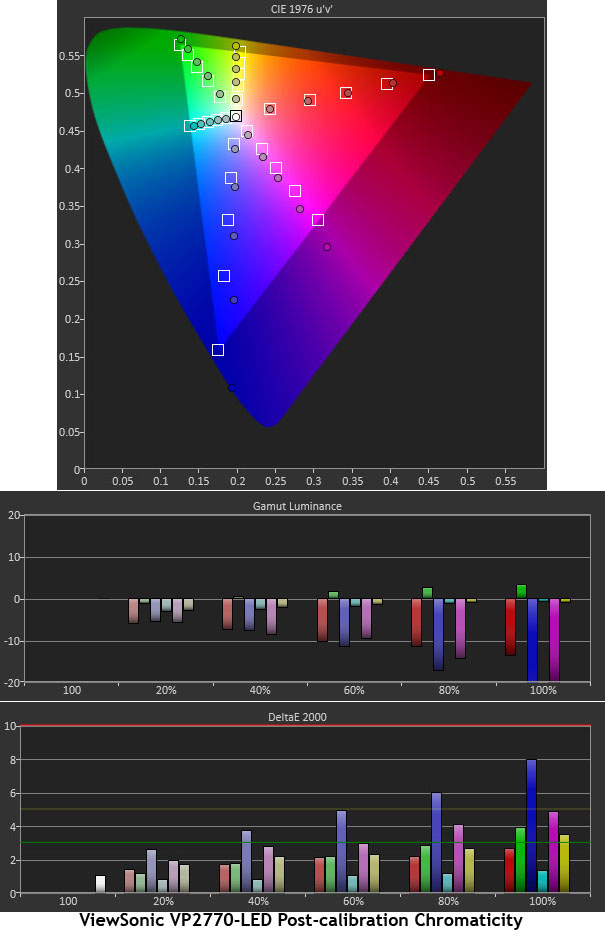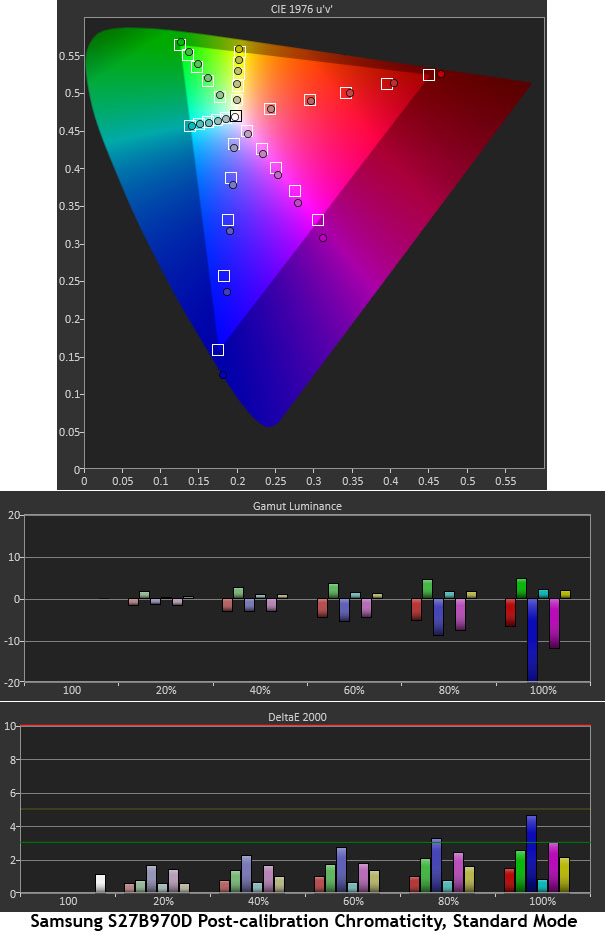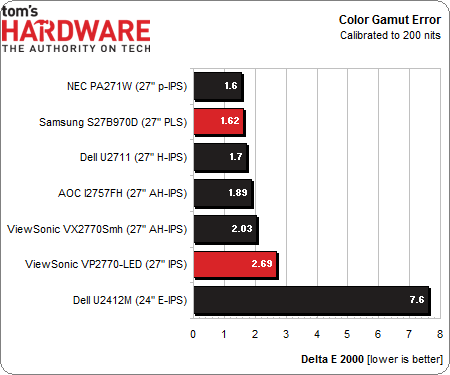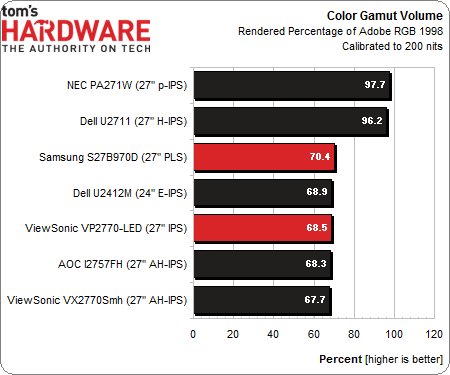VP2770-LED Vs. S27B970D: 27" Monitors At 2560x1440
If you demand maximum pixel density and the highest resolution on your desktop PC, these 27-inch screens from ViewSonic and Samsung do not disappoint. Today, we put ViewSonic's VP2770-LED and Samsung's S27B970D to the test. Is QHD right for you?
Results: Color Gamut And Performance
Color gamut is measured using a saturation sweep that samples the six main colors (red, green, blue, cyan, magenta, and yellow) at five saturation levels (20, 40, 60, 80, and 100%). This provides a more realistic view of color accuracy. Since there are no color management controls on either monitor, we're only showing the post-calibration graphs (although we’re sure they'd look pretty much the same out-of-box).
ViewSonic VP2770-LED
Color luminance is a little low for blue, red, and magenta, and the error increases as the saturation rises. Green, yellow, and cyan maintain almost perfect levels at all saturation points. The net effect on Delta E is small, with the exception of blue, which has visible errors from 40 percent and up. The other colors stay closer to or underneath the visible error level of three. This is a fair result.
Samsung S27B970D
Samsung's S27B970D measures noticeably better than the ViewSonic in its Standard mode. The only color showing any real inaccuracy is blue, but the error is slight. Again, this is mostly caused by its low luminance, especially at 100 percent. Aside from that, this is an extremely accurate panel. We did measure a slightly better result in the sRGB mode, but since this prevented us from correcting any grayscale error, we decided to stick with Standard.
Here is the comparison of post-calibration chromaticity error. Remember that a Delta E value below three is imperceptible to the naked eye.
All of the panels we’ve tested recently have no visible color error. Samsung’s average Delta E value is extremely low at 1.62 in the Standard picture mode. The factory-calibrated mode comes out a bit higher, with a Delta E of 2.69. Coincidentally, ViewSonic also turns out a Delta E value of 2.69. This is excellent performance.
Get Tom's Hardware's best news and in-depth reviews, straight to your inbox.
Gamut Volume: Adobe RGB 1998
There are basically two categories of displays in use today: those that conform to the sRGB standard like HDTVs, and wide-gamut panels that show as much as 100 percent of the Adobe RGB 1998 spec.
The VP2770-LED and S27B970D fall into the former category, making them ideal for gaming and video content. Even out of the box, each screen's image will closely match the TV in your living room. If you require a larger color gamut for photo or graphics production, you’ll need to look elsewhere.
We use Gamutvision to calculate the gamut volume based on an ICC profile created from actual measurements. Given the premium price of the Samsung, we expected at least a wide-gamut option. But alas, there isn’t one. Both screens offer about the same gamut size as their competition.
Monitors that display more of the Adobe RGB 1998 gamut are generally priced higher. But they won't look as good in movies or games due to their higher color saturation. Unless the content is actually mastered using the larger gamut (and none presently is), it won’t display correctly on a monitor designed to conform to Adobe RGB 1998. So, it’s important to select a monitor based on its intended use, rather than the size of its color gamut.
Current page: Results: Color Gamut And Performance
Prev Page Results: Grayscale Tracking Next Page Results: Viewing Angle And Uniformity
Christian Eberle is a Contributing Editor for Tom's Hardware US. He's a veteran reviewer of A/V equipment, specializing in monitors. Christian began his obsession with tech when he built his first PC in 1991, a 286 running DOS 3.0 at a blazing 12MHz. In 2006, he undertook training from the Imaging Science Foundation in video calibration and testing and thus started a passion for precise imaging that persists to this day. He is also a professional musician with a degree from the New England Conservatory as a classical bassoonist which he used to good effect as a performer with the West Point Army Band from 1987 to 2013. He enjoys watching movies and listening to high-end audio in his custom-built home theater and can be seen riding trails near his home on a race-ready ICE VTX recumbent trike. Christian enjoys the endless summer in Florida where he lives with his wife and Chihuahua and plays with orchestras around the state.
-
mayankleoboy1 ReplyWhy wouldn't you want a QHD screen like one of these two?
Everything gets smaller.
So increase the DPI scaling ?
-
MauveCloud BigMack70I'm glad to see 1440p monitors getting some attention, but I just don't see the prices of these being justifiable to most users over the USA-based Korean 1440p IPS panels that are starting to become more numerous.$800-1200 is just nuts for anyone using these for home use or gaming, IMO.Reply
Agreed. I bought a Dell U2711 a few months ago, but if something forced me to replace it, I'd probably go with one of those cheap Korean panels -- or a TN panel 2560x1440 monitor if somebody would actually make one - I doubt I'm the only one who likes the resolution but isn't so picky about color quality. I had no objection to the color quality on my Samsung P2770HD, and the color shifts of a TN panel are affected by the physical size of the monitor, not the resolution, right? -
Why not do a review on those $330 Korean 1440P monitors that enthusiasts talk about? I like to see what i am missing with the extra $900. Really i'm serious i really want to know what justifies the 1 grand price tag.Reply
-
cangelini jupiter optimus maximusWhy not do a review on those $330 Korean 1440P monitors that enthusiasts talk about? I like to see what i am missing with the extra $900. Really i'm serious i really want to know what justifies the 1 grand price tag.It's coming. We're ramping up our display coverage, so we took note of the requests after the last display piece and put in the requests. You'll see this soon. Of course, if there are any other requests from you guys, do let us know. Christian is doing a phenomenal job of applying his extensive experience on Tom's Hardware.Reply -
EzioAs Dell's UltraSharp U2713HM is less than $600 in my country if we go by standard conversion. Would you guys say that's a good price?Reply -
festerovic cangeliniIt's coming. We're ramping up our display coverage, so we took note of the requests after the last display piece and put in the requests. You'll see this soon. Of course, if there are any other requests from you guys, do let us know. Christian is doing a phenomenal job of applying his extensive experience on Tom's Hardware.That's great to hear, I agree with the others that the price of these models is too much to consider unless they were generating $$$s for me. $3-400 seems like the range I would be willing to spend on these. And as for the USA based korean cheap models, are there any legit retailers of these? Please point me at them.Reply -
JOSHSKORN Just bought a ASUS VS278Q-P for $310. It's a 60Mz monitor and I do game, but I'm happy. My previous monitor lasted 8 years (Samsung SyncMaster 213T, bought it for $1k). I'll upgrade when this one dies, hopefully 4k/UHD will be affordable. Supposedly, only serious gamers can tell the difference between 60Hz and 120Hz. I'm not a serious gamer, so it works just fine for me. 120Hz monitors of that size are nearly twice the price.Reply -
mannam Reply10449443 said:It's coming. We're ramping up our display coverage, so we took note of the requests after the last display piece and put in the requests. You'll see this soon. Of course, if there are any other requests from you guys, do let us know. Christian is doing a phenomenal job of applying his extensive experience on Tom's Hardware.
Here are the inexpensive $300-$400 27" korean monitor brands: Yamakasi Catleap, Achieva Shimian, Crossover, PCBank, Potalion, Auria
"The reason these monitors are cheap - LG makes IPS panels for apple cinema displays. Apple only accepts grade A+ panels. That means the all the grade A,A-,B+, etc are not accepted and returned to LG. LG resells those IPS panels to other manufacturers. You can get the whole story on google if you're interested. In addition, you're getting no support and no manufacturers warranty."
Source: http://www.mmorpg.com/gamelist.cfm?game=239&view=forums&post=5192222#5192222
It would be really interesting to get a review of these monitors that go for 50% or less of the price of the Big Brand stuff. If it's even 85-90% quality compared to the big brands, then they are worth the plunge. :D -
ubercake Personally, I was not impressed with the Auria monitor. My Acer HN274H TN monitor has better contrast. Viewing angles are far better on the Auria, but that's to be expected on an IPS. At any rate, I returned the Auria after a day of use because after many attempts to adjust the contrast/color, it didn't hold a candle to the colors or contrast on my TN. The Auria definitely had deeper black, but the in-betweens seemed to be missing no matter how I set the contrast and color. I honestly couldn't justify the tradeoff of higher resolution to lack of contrast. Maybe I got one of the LG B+ throw-away panels?Reply



